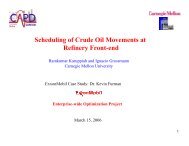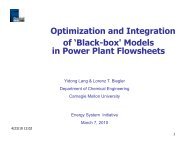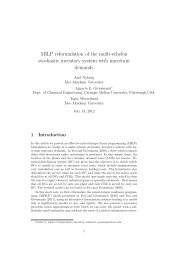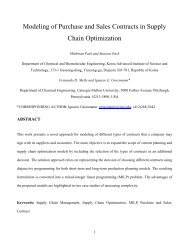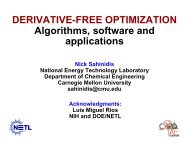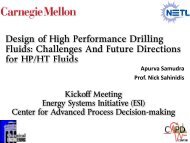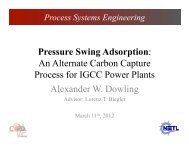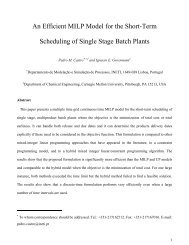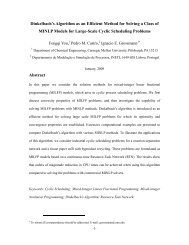Superstructure Optimization of the Olefin Separation Process
Superstructure Optimization of the Olefin Separation Process
Superstructure Optimization of the Olefin Separation Process
You also want an ePaper? Increase the reach of your titles
YUMPU automatically turns print PDFs into web optimized ePapers that Google loves.
BCDEFGHB/CDEFGHBCD/EFGHBCD/CDEFGHBCDEF/CDEFGHBCDEF/EFGHCDEFGHCD/EFGHCDEF/EFGHCDEF/GHCDEFG/HEFGHEF/GHEFG/HEFGEF/GGHG/HC5HGA/BCDEFGHBCDEF/GHBCDEFG/HC4C3H8AB/CDEFGHCD/EFGFABCD/CDEFGHB/CDEFGCDEFGCDEF/EFGEFE/FABCDEF/CDEFGHABCDEFGHABCDEF/EFGHABCD/EFGHBCDEFGBCD/CDEFGBCDEF/CDEFGBCDEF/EFGBCD/EFGBCDEF/GBCDEFCDEF/GB/CDEFBCD/CDEFCDEFCD/EFEC3H6C2H6DABCDEF/GHBCD/EFCDC/DABCDEFG/HABCDEFGA/BCDEFGAB/CDEFGABCD/CDEFGABCDEF/CDEFGCC2H4CH4BSTATESTASKSABCDEF/EFGABCD/EFGABCDEF/GNON-SHARPABCDEFA/BCDEFAB/CDEFABCD/CDEFABCD/EFABCDBCDA/BCDAB/CDB/CDABA/BAH2Figure 1: <strong>Superstructure</strong> <strong>of</strong> separation systemTable 1: <strong>Separation</strong> technologiesT1 Distillation columnT2 Physical absorption towerT3 Membrane separatorT4 DephlegmatorT5 Pressure Swing Adsorption (PSA)T6 Cold BoxT7 Chemical Absorption tower2. GDP modelWe propose a generalized disjunctive programming model for optimizing <strong>the</strong>superstructure <strong>of</strong> <strong>the</strong> separation system shown in Figure 1 (see Yeomans andGrossmann, 1999a, 1999b). The first level in <strong>the</strong> embedded disjunction corresponds to<strong>the</strong> selection <strong>of</strong> <strong>the</strong> separation task. Once <strong>the</strong> separation task is selected, <strong>the</strong> second leveldisjunction is for <strong>the</strong> selection <strong>of</strong> <strong>the</strong> separation technologies. For example, if adistillation column is chosen, <strong>the</strong>n <strong>the</strong> mass and energy balances for distillation columnare enforced and <strong>the</strong> corresponding cost term is considered. An additional disjunction is<strong>the</strong> heat integration for <strong>the</strong> distillation columns, and ano<strong>the</strong>r disjunction is forcompression, pumping or pressure reduction <strong>of</strong> each state. For <strong>the</strong> separation units,simple mass/energy balances are used. Assumptions for modeling <strong>the</strong> separation systemare as follows:1) Vapor pressure <strong>of</strong> <strong>the</strong> stream is calculated with Raoult’s law and by <strong>the</strong> Antoineequation (Reid et al., 1977)2) Utility (cooling water/hot steam) cost is given by a function <strong>of</strong> temperature (seeFigure 2)3) Investment cost is given by concave cost functions (Douglas, 1988)
Based on <strong>the</strong>se assumptions, <strong>the</strong> following nonconvex GDP model is constructed:Indicesi States k Distillation columns <strong>Separation</strong> task st <strong>Separation</strong> technologySetsI States i K Distillation column kS i <strong>Separation</strong> task s for state i ST s <strong>Separation</strong> technology st for task sParametersEMAT Minimum T differenceCR L Lower bound for comp. ratio CR U Upper bound for comp. RatioVariablesx i Flowrate <strong>of</strong> state i T i Temperature <strong>of</strong> state IP i Pressure <strong>of</strong> state i IC i Investment cost for separation <strong>of</strong> iCC i Compressor cost for state i UC i Utility cost for separation <strong>of</strong> IYS i,s Selection <strong>of</strong> separation task YZ i,k Selection <strong>of</strong> heat integration for state iYT s,st Selection <strong>of</strong> separation tech. YC i Selection <strong>of</strong> compression for state iRT i Top recovery ratio <strong>of</strong> state i RB i Bottom recovery ratio <strong>of</strong> state iQEX i,k Heat transferred from state i to distillation column kQ i Heat generated or consumed by state ICT i Condenser temperature in distillation column for IRT k Reboiler temperature in distillation column kModel <strong>Olefin</strong>1:a) Minimize <strong>the</strong> annualized cost <strong>of</strong> capital investment, compression and utilityb) Overall mass balancesmin Z= ∑ i i +i( IC + CC UC )s . t.Ax = 0c) Pressure and temperature calculation by Antoine equationiPi= fa(T ),i∀i∈ Id) Embedded disjunction for <strong>the</strong> separation task∨s∈Si⎡⎢⎢⎢⎢⎢⎢⎢⎢⎢⎢⎣∨st∈STsYSi,s⎤⎥top feedxi= RTixi⎥btm feed⎥xi= RBixi⎥⎡YTsst⎤⎥,,⎢⎥⎥⎢ mass balance : fm(xi) = 0 ⎥⎥⎢⎥energy balance : fe(xi,Ti, Pi, Q ⎥i ) = 0⎢⎥⎥⎢ t fuction ICiUCifc xiTiPiQ ⎥⎣cos: ( , ) = ( , , , i ) ⎥⎦⎦∀i∈ I
select a specific utility stream. However, as shown in Figure 2, <strong>the</strong> utility cost can beapproximated by a smooth function <strong>of</strong> <strong>the</strong> temperature. In this way, we can avoidintroducing <strong>the</strong> binary variables and simplify <strong>the</strong> modeling <strong>of</strong> utility system. Weconstruct a third order regression <strong>of</strong> <strong>the</strong> utility cost, which yields a good approximation.This approximation generally provides an underestimation <strong>of</strong> <strong>the</strong> actual cost <strong>of</strong> <strong>the</strong> utilitystreams because we introduce a continuous relaxation <strong>of</strong> <strong>the</strong> temperature levels <strong>of</strong> <strong>the</strong>utilities.Utility Cost-200.00 -100.00 0.00 100.00 200.00 300.00 400.00 500.00Temp FFigure 2: Utility stream temperatureTotal cost: 110.82 M$/yrAH2heatercompressorDephlegmatorABCDEFGH100F480PsigvalvecoolerABCDCDEFGH84F190Psig480Psig480PsigcompressorDE74F170PsigDeethanizer214F170PsigFigure 3: GAMS optimal solutionEFGH169F160PsigvalveFG238F140Psig109F140PsigDepropanizerpumppumpAB-141F900Psig410 Mkwh/yrGH226F160PsigCold BoxCD-41F160Psig236F140PsigEF83F160PsigGHA/BCD-31F140Psig72F140PsigEF123F140Psig900Psig-51F140PsigChemicalAbsorberC3Splitter99F140PsigDebutanizerBCDEFGHCH4C2H4C2H6C3H6C3H8C4C54. Numerical resultsFigure 3 shows <strong>the</strong> optimal solution for <strong>the</strong> superstructure shown in Figure 1. First <strong>the</strong>compressors are used to increase <strong>the</strong> pressure <strong>of</strong> <strong>the</strong> feed stream to <strong>the</strong> dephlegmator,which separates <strong>the</strong> hydrogen and methane from <strong>the</strong> heavier components. Then <strong>the</strong>hydrogen/methane mixture is sent to <strong>the</strong> cold box and hydrogen is separated from
methane. The cold box operates at <strong>the</strong> low temperature and high pressure which requiresadditional refrigeration and compression. The C 2 -C 5 mixture is sent to <strong>the</strong> deethanizer(distillation column) and <strong>the</strong> C 2 mixture is recovered as top product. The C 3 mixture isseparated by <strong>the</strong> depropanizer, and <strong>the</strong> C 4 -C 5 mixture is sent to <strong>the</strong> debutanizer. Achemical absorber is used for <strong>the</strong> C 2 split and distillation column is used for <strong>the</strong> C 3 split.All <strong>the</strong> separation units perform sharp separations. Note that <strong>the</strong>re is a heat exchangebetween <strong>the</strong> depropanizer and <strong>the</strong> C 3 splitter to reduce <strong>the</strong> utility cost. The annualizedcapital cost <strong>of</strong> <strong>the</strong> process is 39.1M$/yr. The power cost for <strong>the</strong> compressors is29.8M$/yr and <strong>the</strong> utility cost for <strong>the</strong> separation units is 41.9M$/yr. The energy cost isabout 75% <strong>of</strong> <strong>the</strong> total cost. Since <strong>the</strong> olefin separation process is highly energyintensive,a significant amount <strong>of</strong> utility cost can be saved by <strong>the</strong> heat integration. Table2 shows <strong>the</strong> statistics <strong>of</strong> <strong>the</strong> problem, where it can be seen that <strong>the</strong> MINLP problem isvery large. This MINLP was solved in about 2 hours on a Pentium PIII PC usingGAMS/DICOPT++, an algorithm for MINLP problems that is based on <strong>the</strong> OuterApproximation (OA) with Equality Relaxation and Augmented Penalty (Viswanathanand Grossmann, 1990). CPLEX was used for <strong>the</strong> MILP solver and CONOPT2 was usedfor <strong>the</strong> NLP solver in GAMS (release 20.7). The heuristic termination was used that isbased on <strong>the</strong> lack <strong>of</strong> improvement in <strong>the</strong> objective.Table 2: GAMS computational resultsMINLP problem sizeDICOPT++ solutionNumber <strong>of</strong> constraints 52,703 Number <strong>of</strong> iterations 5Number <strong>of</strong> variables 24,475 CPU seconds 8,778Number <strong>of</strong> binary variables 5,851 First integer solution 142.9 M$/yrReferencesBrooke A., Kendrick D., Meeraus A. and Raman R., 1997, GAMS language guide,Release 2.25, Version 92. GAMS Development Corporation.Biegler L.T., Grossmann I.E. and Westerberg A.W., 1997, Systematic methods <strong>of</strong>chemical process design. Prentice Hall, New Jersey.Douglas J.M., 1988, Conceptual design <strong>of</strong> chemical processes. McGraw-Hill, New York.Duran M.A. and Grossmann I.E., 1986, An Outer-Approximation Algorithm for a class<strong>of</strong> Mixed-Integer Nonlinear Programs. Ma<strong>the</strong>matical Programming, 36, 307.Lee S. and Grossmann I.E., 2000, New Algorithms for Nonlinear GeneralizedDisjunctive Programming, Computers and Chem. Eng. 24, 2125.Reid R.C., Prausnitz J.M. and Sherwood T.K., 1977, The properties <strong>of</strong> Gases andLiquids, 3 rd edition. McGraw-Hill, New York.Viswanathan J. and Grossmann I.E., 1990, A Combined Penalty Function and Outer-Approximation Method for MINLP <strong>Optimization</strong>, Computers and Chem. Eng.14, 769.Yeomans H. and Grossmann I.E., 1999a, A Systematic Modeling Framework <strong>of</strong><strong>Superstructure</strong> <strong>Optimization</strong> in <strong>Process</strong> Syn<strong>the</strong>sis, Computers and Chem. Eng.23, 709.Yeomans H. and Grossmann I.E., 1999b, Nonlinear disjunctive programming models for<strong>the</strong> syn<strong>the</strong>sis <strong>of</strong> heat integrated distillation sequences, Computers and Chem.Eng. 23, 1127.AcknowledgmentsThe authors would like to thank BP for financial support <strong>of</strong> this project



